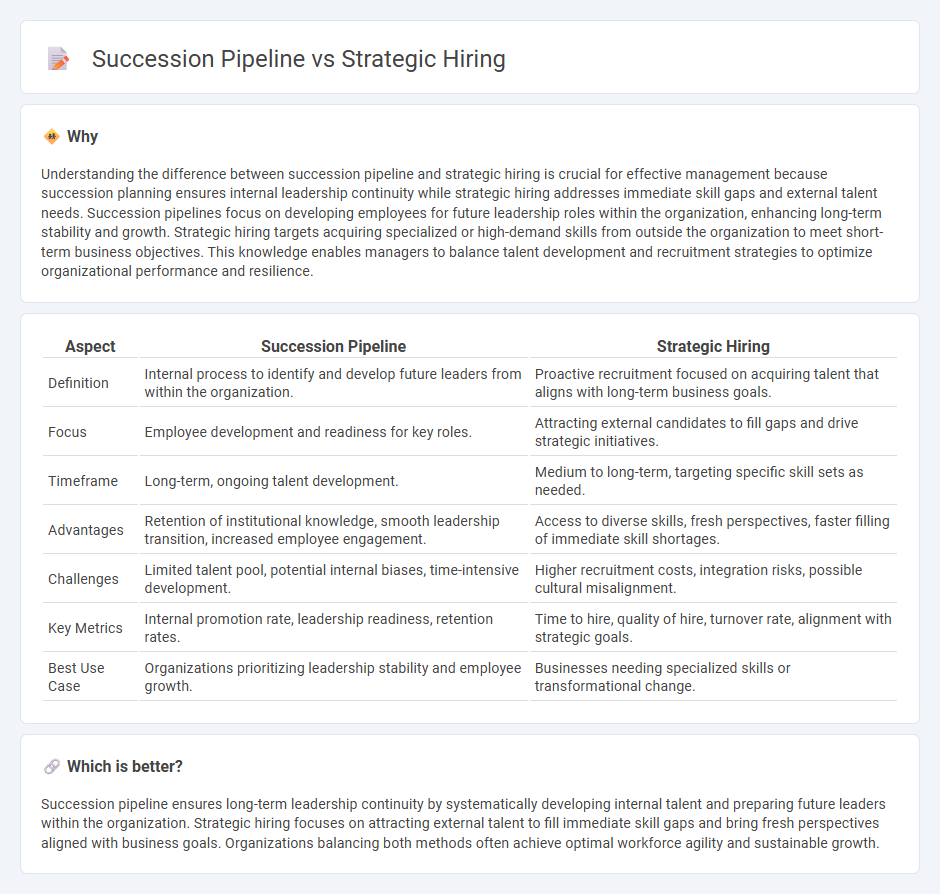
Succession pipeline development focuses on identifying and nurturing internal talent to fill key leadership roles, ensuring business continuity and preserving institutional knowledge. Strategic hiring targets external candidates with specialized skills and fresh perspectives to address immediate organizational gaps and drive innovation. Explore how integrating succession planning with strategic hiring can optimize workforce agility and long-term success.
Why it is important
Understanding the difference between succession pipeline and strategic hiring is crucial for effective management because succession planning ensures internal leadership continuity while strategic hiring addresses immediate skill gaps and external talent needs. Succession pipelines focus on developing employees for future leadership roles within the organization, enhancing long-term stability and growth. Strategic hiring targets acquiring specialized or high-demand skills from outside the organization to meet short-term business objectives. This knowledge enables managers to balance talent development and recruitment strategies to optimize organizational performance and resilience.
Comparison Table
| Aspect | Succession Pipeline | Strategic Hiring |
|---|---|---|
| Definition | Internal process to identify and develop future leaders from within the organization. | Proactive recruitment focused on acquiring talent that aligns with long-term business goals. |
| Focus | Employee development and readiness for key roles. | Attracting external candidates to fill gaps and drive strategic initiatives. |
| Timeframe | Long-term, ongoing talent development. | Medium to long-term, targeting specific skill sets as needed. |
| Advantages | Retention of institutional knowledge, smooth leadership transition, increased employee engagement. | Access to diverse skills, fresh perspectives, faster filling of immediate skill shortages. |
| Challenges | Limited talent pool, potential internal biases, time-intensive development. | Higher recruitment costs, integration risks, possible cultural misalignment. |
| Key Metrics | Internal promotion rate, leadership readiness, retention rates. | Time to hire, quality of hire, turnover rate, alignment with strategic goals. |
| Best Use Case | Organizations prioritizing leadership stability and employee growth. | Businesses needing specialized skills or transformational change. |
Which is better?
Succession pipeline ensures long-term leadership continuity by systematically developing internal talent and preparing future leaders within the organization. Strategic hiring focuses on attracting external talent to fill immediate skill gaps and bring fresh perspectives aligned with business goals. Organizations balancing both methods often achieve optimal workforce agility and sustainable growth.
Connection
Succession pipeline development ensures a continuous flow of qualified leaders by identifying and nurturing internal talent aligned with organizational goals. Strategic hiring complements this process by targeting external candidates who fill critical skill gaps and enhance leadership diversity. Together, they create a robust framework for long-term leadership sustainability and organizational resilience.
Key Terms
Talent Acquisition
Strategic hiring targets immediate organizational needs by sourcing highly qualified candidates aligned with business goals, whereas a succession pipeline builds a long-term talent pool for leadership continuity and internal growth. Talent acquisition integrates both approaches by balancing external recruitment efforts with the development of internal talent to ensure sustainable workforce readiness. Explore how combining strategic hiring and succession pipelines can maximize your talent acquisition strategy.
Leadership Development
Strategic hiring prioritizes acquiring external talent with specialized skills for immediate leadership gaps, while succession pipeline focuses on cultivating internal candidates through targeted leadership development programs. Developing a robust succession pipeline enhances organizational stability by preparing high-potential employees for future executive roles. Explore effective leadership development strategies to optimize your hiring and succession planning processes.
Workforce Planning
Strategic hiring aligns talent acquisition with long-term business goals, focusing on securing skilled professionals who meet current and future organizational needs. Succession pipeline development emphasizes identifying and preparing internal candidates for critical leadership roles to ensure seamless transitions and business continuity. Explore how integrating strategic hiring with succession planning enhances workforce planning effectiveness.
Source and External Links
Strategic Hiring - HeroHunt.ai - Strategic hiring involves identifying and hiring employees who align with an organization's long-term goals, often using methods like talent assessments and employee referral programs.
What is Strategic Hiring? Meaning & Example - Skima AI - Strategic hiring is a method for identifying and onboarding skilled employees whose characteristics fit the company's objectives and culture, using strategies like employer branding and talent pipelining.
What Is A Strategic Hire? The 7 Steps You Need in 2025 | Vouch - Strategic hiring involves a systematic approach to finding and hiring the best candidates through steps like building an employer brand and defining hiring goals.
 dowidth.com
dowidth.com